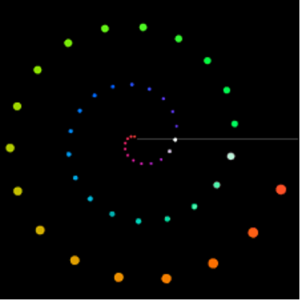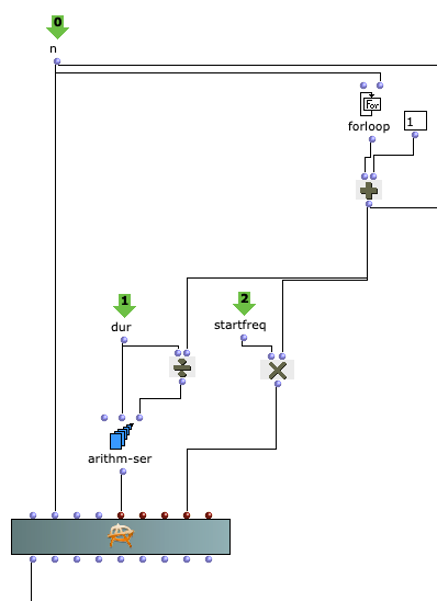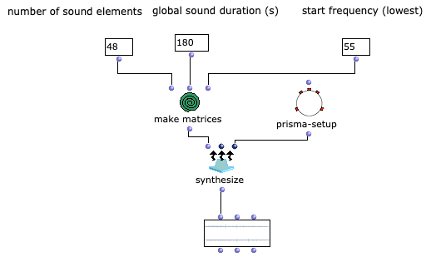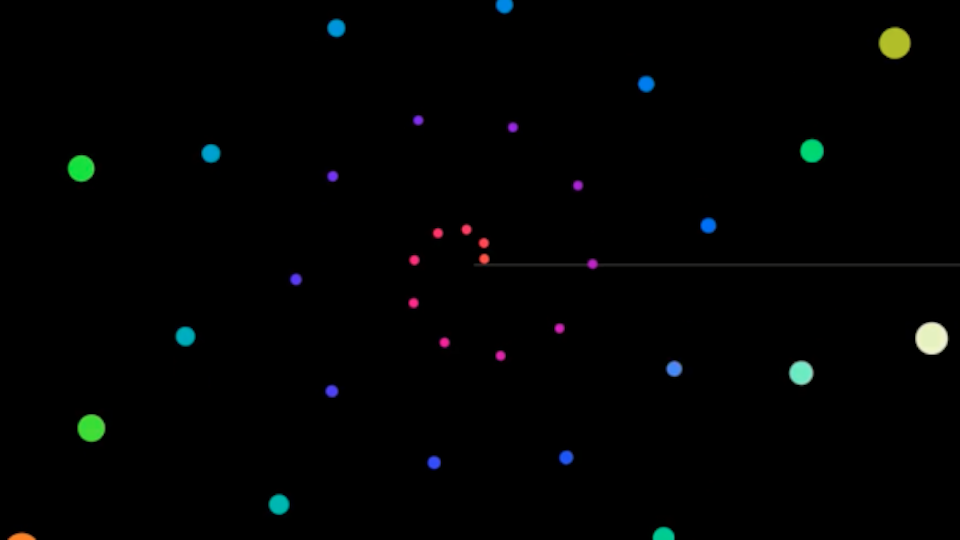The Whitney Music Box is a sonified and/or visual representation of a series of interrelated sound elements. From a musical point of view, these elements can be related chromatically or harmonically, for example. In the visual representation, each of these elements is represented by a circle or dot (see Figure 1). These dots circle around a common center point depending on their own assigned frequency. The lower the frequency, the smaller the radius of the orbiting circle and the higher the orbital speed. Each sound element represents multiples of a fixed fundamental frequency in a harmonic series. As soon as an element has completed a revolution around the center point, the sound is triggered with the frequency it represents. Due to the mathematical relationship between the individual elements, there are moments during the performance of the Whitney Music Box in which certain elements are triggered simultaneously and phases in which the elements can be perceived consecutively. At the beginning and at the end, all elements are triggered simultaneously.

Figure 1: Whitney Music Box – visual representation
In this project, OMChroma is used to synthesize the individual sound elements (see Figure 2). The synthesis classes of OMChroma inherit from OpenMusic’s class-array object. The columns in the array describe the individual components within the synthesis. The rows represent parameters that can be assigned locally to the individual components or globally to the entire process. For the Whitney Music Box, elements are needed that implement the individual pitch gradations and the temporal offset of the individual pitch gradations. An OMChroma matrix is regarded as an event. Such an event represents a pitch and the sound repetitions within the global duration of the Whitney Music Box. The global duration is defined at the beginning and also describes the round trip time of the lowest frequency or the previously defined start frequency. Each matrix represents a frequency that is a multiple of the start frequency. The round trip time of a sound element is calculated using the formula
duration(global) / n
Where n is the index of the individual sound elements or matrices. The higher the index, the higher the frequency and the shorter the round trip time. The repetitions of the sound elements are defined by the parameter e-dels . Each component of a matrix is given a different entry delay. These entry delays are spaced at regular intervals of duration(global) / n.

Figure 2: Application of OMChroma
Without spatialization, the Whitney Music Box with OMChroma sounds like this:
Alex Player - Best audio playerFigure 3 shows how the collected matrices or sound events are spatialized with the OMPrisma library. This was based on the visual representation of the Whitney Music Box. Sound elements with a low frequency are further away from the center and sound elements with a high frequency circle closer to the center. With OMPrisma, this representation is to be implemented in spatial sound. This means that sounds with a low frequency should sound further away and sounds with a high frequency should sound closer to the listener. In the OpenMusic patch, elements with an even index were also positioned further to the front and further to the right and, similarly, elements with an odd index were positioned further to the left and back in order to distribute the sounds evenly in the room. The OMPrisma classes also offer presets for the attenuation function, air-absorption function and time-of-flight function . These were used to create an even greater sense of spatiality in addition to the positioning in the room.

Figure 3: Application of OMPrisma
In stereo, for example, the Whitney Music Box sounds like this:
Figure 4 shows how the collected OMChroma and OMPrisma matrices are merged using the chroma-prisma function. The list of all collected matrices is returned via an om-loop and rendered as a sound using the synthesize function(see Figure 5).

Figure 4: chroma-prisma

Figure 5: loop and synthesize
The OpenMusic patch and sound samples can be downloaded from the following link: https://github.com/lauraptrcodes/Whitney-music-box
